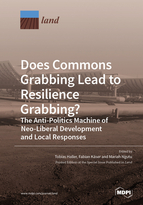Does Commons Grabbing Lead to Resilience Grabbing? The Anti-Politics Machine of Neo-Liberal Development and Local Responses
A special issue of Land (ISSN 2073-445X).
Deadline for manuscript submissions: closed (31 August 2019) | Viewed by 70203
Special Issue Editors
Interests: environmental perceptions; large-scale land acquisitions; gender and resource management; climate change; bottom-up institution building processes (constitutionality)
Special Issues, Collections and Topics in MDPI journals
Interests: agriculture; large scale land acquisitions; food systems; institutions; africa; political ecology
Interests: agro-industrial companies; food systems; institutions; commons (water); gender
Special Issue Information
Dear Colleagues,
This Special Issue contributes to the debate on land grabbing as commons grabbing with a special focus on how the development of state institutions (formal laws and regulations for development and compensations) and voluntary corporate social responsibility (CRS) initiatives have enabled the grabbing process. It also looks at how these institutions and CSR programs are used as development strategies of states and companies to legitimate their investments (Anseew et al 2012, Lavers 2012, Schoeneveld and Zoomers 2015). This Special Issue calls for contributions analyzing how these strategies are embedded into neo-liberal ideologies of economic development (Escobar 2010, Haller 2013). We propose looking at James Ferguson’s notion of the Anti-Politics Machines (1990, 2006) that served to uncover the hidden political basis of state-driven development strategies. We think it is of interest to test the approach for analyzing development discourses and CSR-policies in investments. We argue that these legitimize the institutional change from common to state and private property of land and land related common pool resources (Haller ed 2010), which is the basis of commons grabbing. This Special Issue welcomes contributions that show how investments, in fact, affect not “wastelands”, but land-related common pool resources, previously held in common property institutions. We are also interested in the way institutional change leads to legal and institutional pluralism, and how companies and local elites select from this plurality of institutions (labeled as institution shopping, see Toulmin 2009, Haller 2016). Furthermore research suggests that investments using institutional pluralism related to development, not only lead to commons grabbing (Haller 2016), but also to “resilience grabbing”.: CSR programs and compensations in the form of cash or employment do not cover the loss of a common pool resources for subsistence and cash. Especially, women and minorities are not able to get access to the few jobs available and to the low, as well as unequal, distribution of compensations (Marfurt et al 2016). As a consequence, local people are more vulnerable to environmental disturbances. However, we also look for contributions presenting perceptions and responses of commoners to the grabbing-process, which literature suggests ranges from weapons of the weak (Scott 1984) to options of mobilization (Politics Machines see Niederberger et al 2016), including institution shopping from below (on customary and human rights) and bottom-up institution building (Constitutionality see Haller, Acciaioli and Rist 2016) to reclaim to the commons.
References
- Anseeuw, W.; Boche, M.; Breu, T.; Giger, M.; Lay, J.; Messerli, P.; Nolte, K. Transnational Land Deals for Agriculture in the Global South: Analytical Report Based on the Land Matrix Database; CDE/CIRAD/GIGA: Bern/Montpellier/Hamburg, 2012, ISBN: 978-92-95093-71-3.
- Ferguson, J. The Anti-Politics Machine. “Development” and Bureacuratic Power in Lesotho. Cambridge: Cambridge University Press: Cambridge, UL, 1990.
- Ferguson, J. 2006. Global Shadows: Africa in the Neoliberal World Order; Duke University Press: Durham/London, UK, 2006
- Haller, T. The contested floodplain: institutional change of the commons in the Kafue Flats, Zambia; Lexington Books: Lexington: Lanham, MD, 2012.
- Haller, T. Managing the Commons with Floods: The role of institutions and power relations for water governance and food resilience in African Floodplains. In, Water and Food—Africa in a Global Context. Ostegard, T., Ed. The Nordic African Institute: Uppsala, Sweden, 2016, pp. 369–397.
- Lavers, T. ‘‘Land grab” as development strategy? The political economy of agricultural investment in Ethiopia. Peasant Stud. 2012, 39, 105–132.
- Niederberger, T.; Haller, T.; Gambon, H.; Kobi, M.; Wenk, I. (eds.) 2016. The Open Cut: Mining, Transnational Corporations and Local Populations. LIT Verlag: Berlin, Germany; London, UK, 2016
- Schoneveld, G.C.; Zoomers, A. Natural resource privatisation in Sub-Saharan Africa and the challenges for inclusive green growth. Dev. Plan. Rev. 2015, 37, 95–118.
- Scott, J.C. Everyday Forms of Resistance. In Colburn, F.D. (Hg.): Everyday Form of Peasant Resistance: M.E. Sharp: Armonk, NY, USA, 1989; pp. 3–33.
Prof. Dr. Tobias Haller
Dr. Mariah Ngutu
Dr. Fabian Käser
Guest Editors
Manuscript Submission Information
Manuscripts should be submitted online at www.mdpi.com by registering and logging in to this website. Once you are registered, click here to go to the submission form. Manuscripts can be submitted until the deadline. All submissions that pass pre-check are peer-reviewed. Accepted papers will be published continuously in the journal (as soon as accepted) and will be listed together on the special issue website. Research articles, review articles as well as short communications are invited. For planned papers, a title and short abstract (about 100 words) can be sent to the Editorial Office for announcement on this website.
Submitted manuscripts should not have been published previously, nor be under consideration for publication elsewhere (except conference proceedings papers). All manuscripts are thoroughly refereed through a single-blind peer-review process. A guide for authors and other relevant information for submission of manuscripts is available on the Instructions for Authors page. Land is an international peer-reviewed open access monthly journal published by MDPI.
Please visit the Instructions for Authors page before submitting a manuscript. The Article Processing Charge (APC) for publication in this open access journal is 2600 CHF (Swiss Francs). Submitted papers should be well formatted and use good English. Authors may use MDPI's English editing service prior to publication or during author revisions.
Keywords
- Land grabbing, commons, resilience, development discourses
- Anti-Politics Machine
- Corporate Social Responsibility (CSR), institution shopping, gender
- Constitutionality








